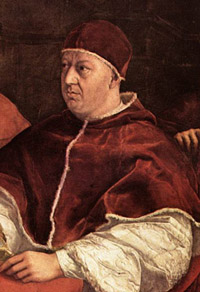
Pope Leo X (1475-1521) was the son o Lorenzo the Magnificent and Clarice Orsini. His teachers included the humanists who frequented the Palazzo Medici in Florence, such as Angelo Poliziano, Pico della Mirandola and Marsilio Ficino.
By the age of eight he was admitted into minor orders, and by 1486 he was Abbot of Montecassino and Morimondo. He spent three years at the University of Pisa, where he was introduced to the study of theology and canon law by Filippo Decio among others. In 1492 he was made a cardinal by Pope Innocent VIII.
When his brother Piero de’ Medici (1471–1503) was expelled from Florence in 1494, Giovanni also went into exile, which he spent mainly in Città di Castello, Perugia, Urbino and Milan; in 1499 he travelled to Germany, the Netherlands and France.
In 1500 he went to Rome, occupying the Palazzo di San Eustachio, later the Palazzo Madama, where he gathered around him many of the leading personalities in Rome, including the writers Tommaso Inghirami and Jacopo Sadoleto and the artist Baldassare Peruzzi. During his years as cardinal, he commissioned the rebuilding of Santa Maria in Domenica and the façade of Santa Cristina in Bolsena, Rome.
He was appointed papal legate in Bologna by Pope Julius II, and in 1512, with the support of the Pope, he secured the return of the Medici to Florence. When Julius II died in 1513, the 37-year-old Giovanni was elected pope as Leo X.
Like his father, Leo X devoted much of his time to the arts and sciences. He attracted Paolo Giovio to the Roman university, set up Greek colleges in Rome and Florence, promoted the study of Hebrew and Arabic writings and, not least, gave strong support to printing. By 1508 he had brought the remains of his father’s library from Florence and set up a private library in Rome, which, like the Vatican library, he enriched with rare manuscripts and books from Europe and the East.
He also supported scholars and poets, including Pietro Bembo, Francesco Guicciardini, Baldassare Castiglione, Giangiorgio Trissino, Jacopo Sannazaro and Marco Girolamo Vida. Under his aegis, Bernardo Bibbiena’s La Calandria was performed, and Ludovico Ariosto staged his Suppositi in 1519, with décor by Peruzzi and Raphael. He had a large collection of musical instruments and maintained a private orchestra as well as the official papal musicians.
Although his patronage of art did not match that of his predecessor, Leo continued most of the buildings begun under Julius II and their decoration, notably the decoration of the Vatican staterooms, the Stanze, begun by Raphael in 1508. The frescoes in the Stanza della Segnatura were completed before Leo X’s election, and those in the two adjoining rooms were painted during his pontificate. In the Stanza di Eliodoro (photo bellow), Leo is depicted on the white horse he rode in the battle of Ravenna.
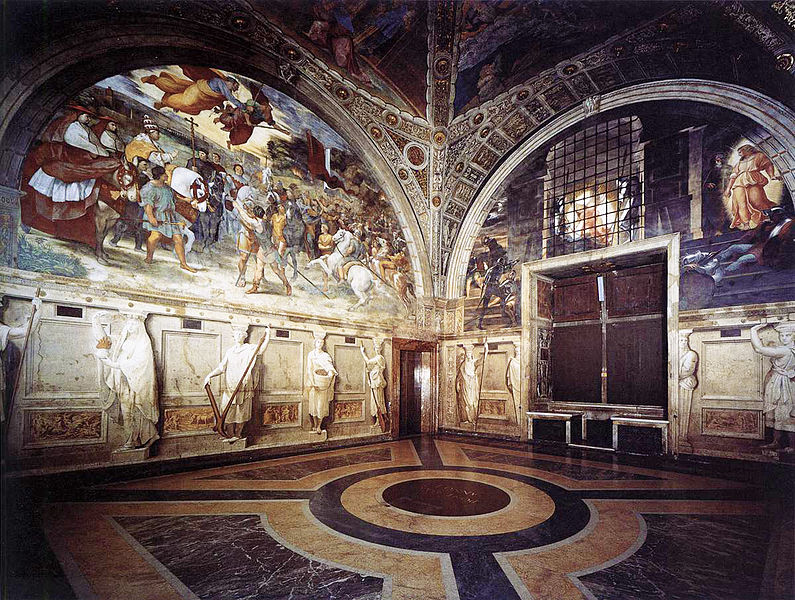
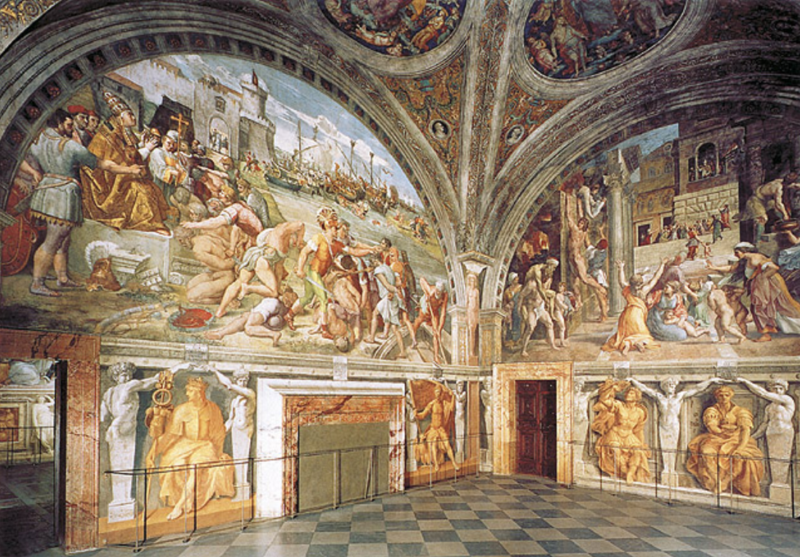
The frescoes in the Stanza dell’Incendio (photo bellow) are also designed to demonstrate Leo X’s power, as the scenes from the lives of the earlier popes Leo III and IV allude to his own political activities.
Another important commission for Raphael was the design of a set of ten tapestries illustrating the Acts of the Apostles Peter and Paul, intended for the lower walls of the Sistine Chapel in the Vatican. The tapestries, which were executed in the workshop of Pieter van Aelst in Brussels, are in Rome in Pinacoteca Vaticana; the seven surviving cartoons by Raphael are in London at the Victoria and Albert Museum.
Although the main fields are devoted to the Apostles, the border scenes glorify Leo X, portraying events from his time as cardinal (see bellow the St Paul Preaching in Athens).
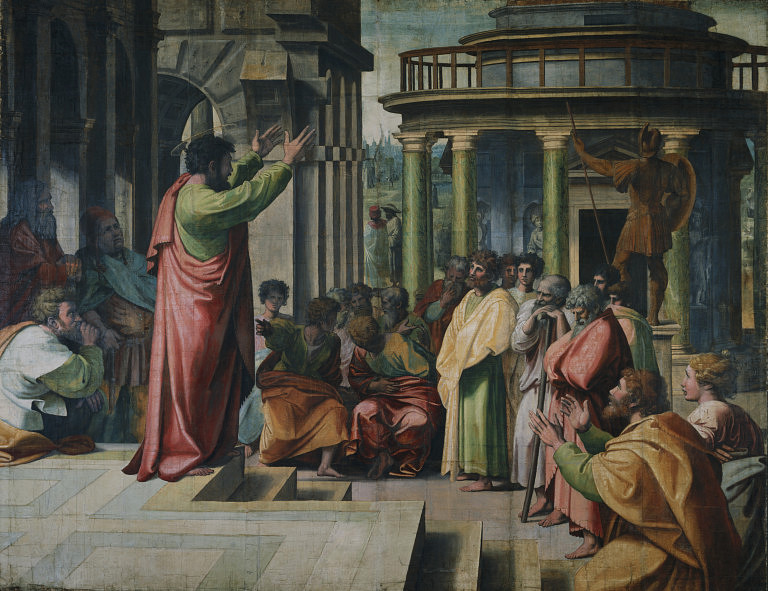
From 1513 Leo had open galleries, Logge, built on the east side of the Vatican palace, overlooking the courtyard of San Damaso. In 1518–1519 the walls were decorated with frescoes designed by Raphael, 52 biblical scenes and grotesque figures based on antique models.
Leo also commissioned several paintings from Raphael, including his portrait (Leo X with Cardinals Giulio de’ Medici and Luigi de’ Rossi). He gave no significant commissions to other artists who came to Rome, including Leonardo da Vinci and Sodoma.
Leo’s main area of patronage was architecture. To continue the rebuilding of St Peter’s, begun by Donato Bramante, he employed Fra Giovanni Giocondo, Giuliano da Sangallo, Raphael, Antonio da Sangallo and Peruzzi, but the work made little progress.
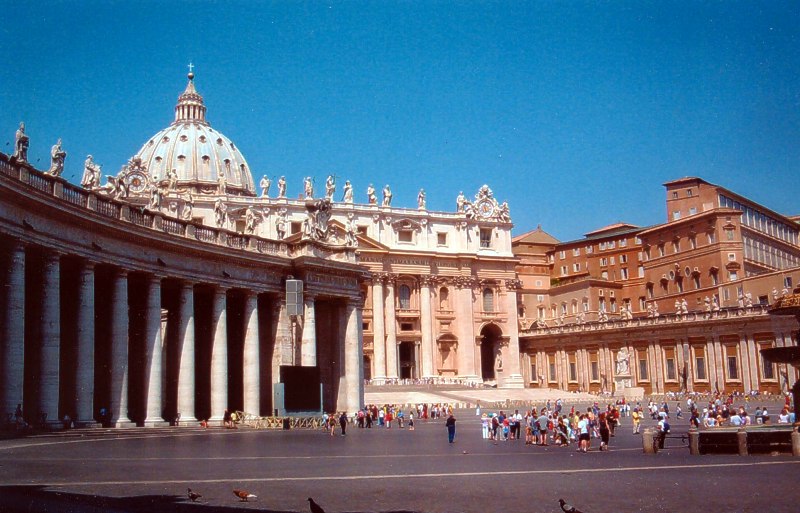
He commissioned a new church in Rome, for his fellow Florentines, San Giovanni dei Fiorentini, begun by Jacopo Sansovino. He had chapels built in the Cortile di Onore of the Castel Sant’Angelo and restored several churches in Rome, including Santa Maria Maggiore, Santa Maria sopra Minerva, the baptistery of San Giovanni in Laterano, as well as the monastery of San Cosimato.
He also had the streets of Rome widened and improved, commissioned Giuliano da Sangallo to extend the Via Alessandrina and laid out three streets leading to the Piazza del Popolo. To stop the destruction of the remains of ancient Rome, in 1515 he appointed Raphael Romanarum Antiquitatum Praes, a post that entailed the conservation of antiquities in Rome and its environs and the supervision of excavations. One of the most important archaeological discoveries during Leo’s pontificate was the excavation of the monumental antique statue of the river-god Nile.
Leo’s patronage also extended outside Rome. In 1513 he commissioned the marble-carving on the Santa Casa in the basilica of Santa Maria at Loreto from Andrea Sansovino, assisted by Baccio Bandinelli, Niccolò Tribolo, Francesco da Sangallo and Raffaello da Montelupo. In Florence in 1516 he commissioned Michelangelo to design a façade for San Lorenzo, which was never built. In 1519 he entrusted Michelangelo with another project, the building and decoration of the New Sacristy of San Lorenzo, including Medici family tombs.
His relations with Michelangelo were often strained, and on several occasions Leo withdrew commissions already granted, notably the statue of Hercules intended as a pendant for Michelangelo’s David, which was transferred to Baccio Bandinelli. Leo had the Medici Villa at Poggio a Caiano rebuilt and decorated between 1520 and 1521 with frescoes by Andrea del Sarto, Pontormo and Franciabigio. Leo also collected small objets d’art, gems, cameos and medals. He had his papal seal made by Pietro Maria Serbaldi da Pescia and employed other important medallists such as Vittore Gambello, Caradosso and Valerio Belli. The period of Leo X’s pontificate was a minor golden age, though as a result of his generous patronage he left not only numerous works of art but debts amounting to 600,000 ducats.
